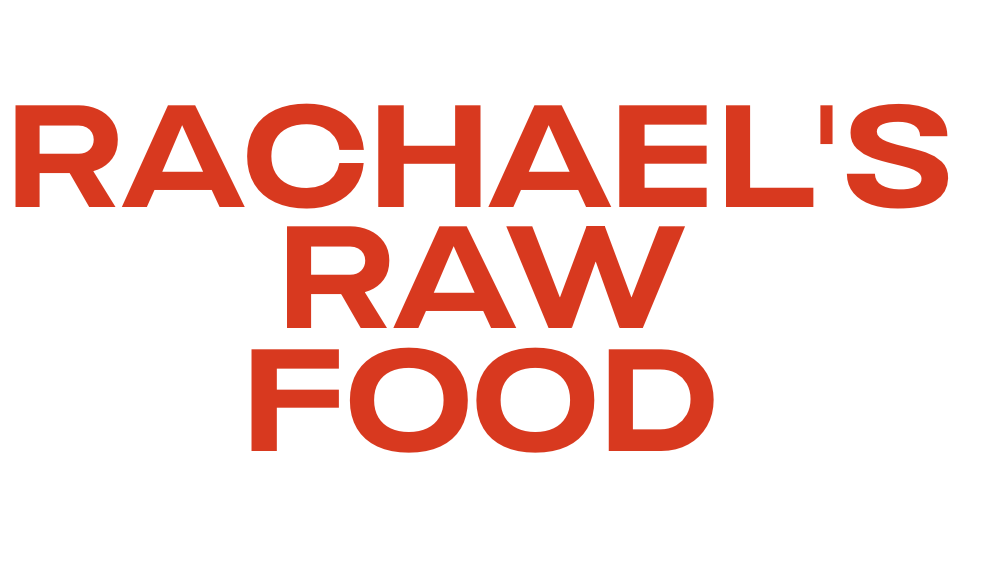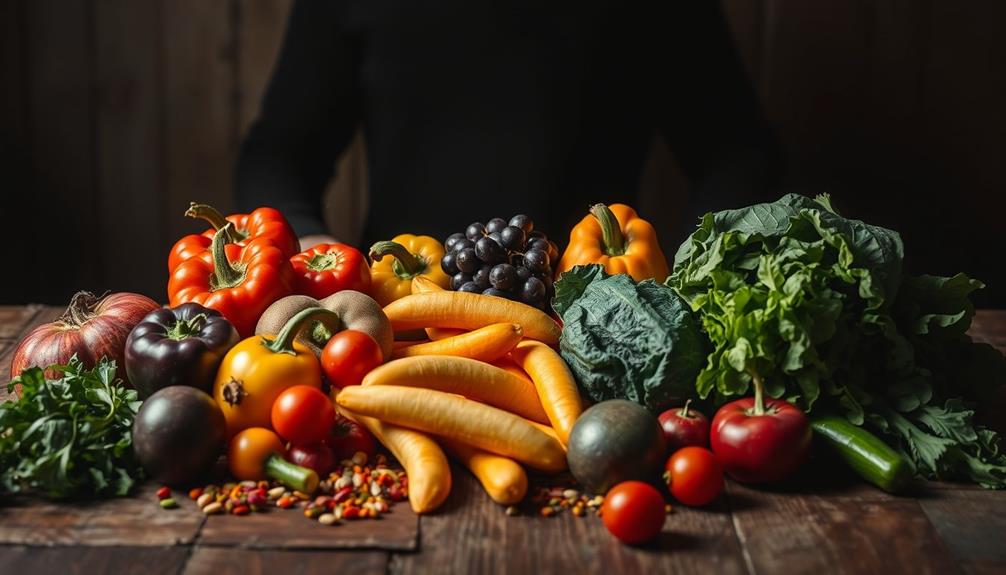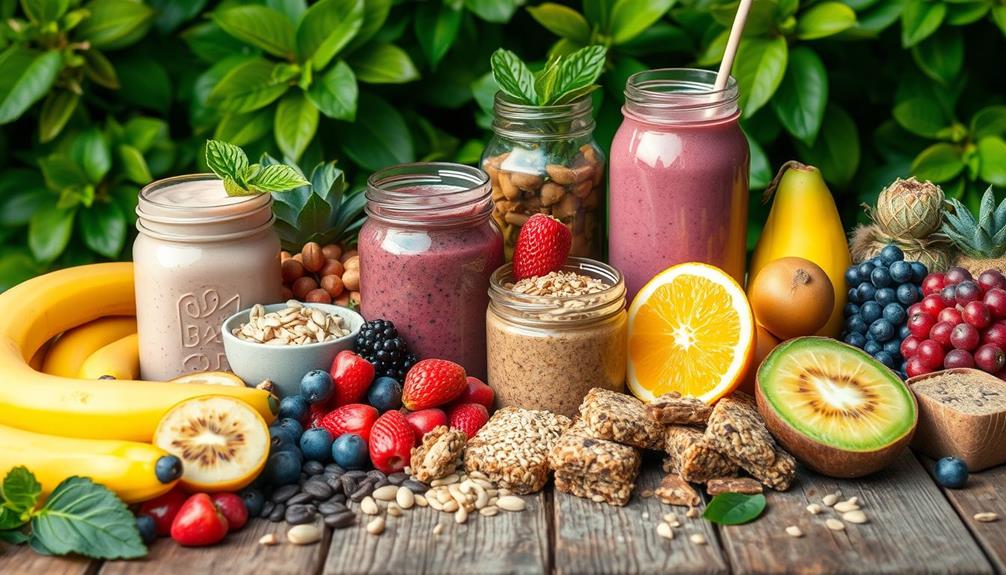Raw food can indeed pose serious health risks that might even threaten your life. Foods like raw meat, eggs, and certain vegetables can carry harmful bacteria such as Salmonella and E. coli. These pathogens can cause severe foodborne illnesses, especially in vulnerable groups like children and pregnant women. Even raw plants can contain natural toxins or be contaminated with dangerous bacteria. While raw diets often claim health benefits, it's vital to understand the risks involved. If you're curious about how to safely enjoy raw foods while minimizing these dangers, there's more essential information ahead for you.
Key Takeaways
- Raw animal products, like meat, poultry, and eggs, can harbor dangerous pathogens that cause severe foodborne illnesses.
- Consuming raw fish dishes may expose individuals to harmful parasites, such as anisakis.
- High-risk groups, including children and pregnant women, face heightened dangers from raw food consumption.
- Cooking food to recommended internal temperatures effectively eliminates health threats from harmful bacteria and parasites.
- Certain raw plant products can contain natural toxins and bacteria, increasing the risks of foodborne illnesses.
Understanding Raw Food Risks
When it comes to raw food, understanding the risks is essential for your health. Consuming raw meat, poultry, seafood, and eggs can expose you to harmful bacteria and parasites, greatly increasing your chances of food poisoning. Pathogens like Salmonella, E. coli, and Listeria are notorious for causing severe foodborne illnesses that can lead to hospitalization or, in extreme cases, death. Taking proper precautions, such as cooking meat and seafood to the appropriate temperature and properly washing fruits and vegetables, can help mitigate these risks. Additionally, it’s important to consider risk factors in food contamination, such as cross-contamination between raw and cooked foods, improper storage temperatures, and unclean surfaces and utensils. Being aware of these factors and practicing good food safety habits can go a long way in protecting yourself and your loved ones from foodborne illnesses.
Additionally, cold medications overview can provide critical information on managing symptoms if foodborne illnesses occur. High-risk groups, including children, pregnant women, and the elderly, should be especially cautious. They're more vulnerable to foodborne illnesses, making it important for them to avoid raw foods altogether.
Even raw fish dishes, such as sushi and ceviche, carry risks; they may contain parasites like anisakis, which can cause serious health issues.
It's not just animal products you need to worry about. Uncooked plant foods can harbor harmful bacteria and anti-nutrients, especially if they aren't washed properly.
To safeguard your health, cooking food to the right internal temperatures—165°F for poultry and 145°F for fish—effectively eliminates these threats, making cooked food the safest option for consumption.
Stay informed and prioritize your health by understanding these risks.
Dangers of Raw Animal Products

Raw animal products can pose serious health risks, making it vital to understand what you're consuming. Dishes like sushi, ceviche, and steak tartare may seem appealing, but they can harbor dangerous bacteria and parasites.
For instance, consuming raw or undercooked pork can expose you to harmful pathogens like salmonella and E. coli, which thrive in improperly cooked meat. It's essential to cook pork to a minimum internal temperature of 145°F to guarantee safety.
Additionally, awareness of financial considerations for elderly care can help individuals navigate their choices, especially when it comes to food safety and health.
Oysters, often eaten raw, can carry viruses and bacteria that lead to severe illnesses such as vibriosis and hepatitis A. Cooking these shellfish thoroughly eliminates these risks.
Similarly, raw eggs are notorious for being a source of salmonella, and they should always be cooked until both the white and yolk are firm.
Even seemingly safe dishes like steak tartare and carpaccio present significant health risks, with potential infections from trichinellosis and E. coli.
To protect yourself from foodborne illnesses, always prioritize proper cooking methods over the allure of raw or undercooked options. Be aware of these health risks to make informed choices about your food.
Risks of Raw Plant Products

When you choose raw plant products, you might be exposing yourself to harmful bacteria that can cause foodborne illnesses.
Additionally, some parts of raw plants contain toxins that can be harmful if consumed.
For instance, certain foods may harbor natural compounds that could lead to adverse health effects, similar to how essential oils like eucalyptus oil can offer benefits when used properly.
It's crucial to understand these risks to make informed choices about what you eat.
Bacterial Contamination Risks
Many people underestimate the bacterial contamination risks associated with consuming raw plant products. While you might think washing fruits and vegetables suffices, harmful bacteria can still linger, leading to foodborne illnesses. It's essential to be aware of how bacterial contamination can affect your health.
| Risk Factor | Impact on Food Safety |
|---|---|
| Unwashed produce | High risk of bacteria |
| Sprouts | Warm, humid conditions favor bacteria |
| Pesticide residues | Potential health issues |
| Anti-nutrients | Inhibit nutrient absorption |
Raw meat often gets the spotlight when discussing bacterial contamination, but raw plant products aren't exempt. Without proper washing, you risk consuming bacteria from food handlers and the environment. Sprouts pose a particular threat because they thrive in conditions that encourage bacterial growth.
To minimize these risks, always verify you wash your produce thoroughly and consider cooking certain items. Your health is paramount, and understanding food safety practices can make a significant difference in preventing foodborne illnesses.
Toxic Plant Parts
Certain parts of plants can be surprisingly harmful, posing serious health risks if consumed. For instance, raw rhubarb leaves contain toxic compounds like oxalic acid and anthraquinone glycosides. Eating these leaves can lead to severe symptoms, including nausea, vomiting, and even kidney damage or respiratory failure in extreme cases.
Additionally, some raw foods, like beetroot, can cause throat irritation due to oxalates, highlighting the significance of preparation methods, such as cooking, to reduce these harmful effects. While many raw foods offer excellent nutritional value, it's essential to recognize that some raw vegetables may harbor harmful bacteria, increasing your risk of foodborne illnesses. If you don't wash them properly before consumption, you could expose yourself to these dangers.
Consult a healthcare provider regarding potential interactions with certain plant foods. Additionally, some raw plant products contain anti-nutrients that inhibit nutrient absorption, potentially leading to deficiencies over time.
You should always wash fruits and vegetables thoroughly to minimize pesticide exposure and reduce contamination risks. Also, be aware of individual food sensitivities or allergies, as they can cause adverse reactions to certain raw foods.
Health Impacts of Foodborne Illness

Foodborne illnesses pose serious health risks, especially for those who consume raw or undercooked foods. Each year, these illnesses account for about 500,000 deaths worldwide, underscoring the dangers of improper food handling. Common pathogens like Salmonella, E. coli, and Listeria lurk in raw meat and animal products, leading to severe gastrointestinal issues.
Vulnerable populations, such as children, pregnant women, and the elderly, face heightened risks of complications. For these groups, avoiding raw or undercooked foods is essential. Cooking meat to the recommended internal temperatures—165°F for poultry and 145°F for pork—effectively eliminates harmful bacteria and reduces the likelihood of foodborne illness.
Here's a quick overview of some common pathogens and their associated health risks:
| Pathogen | Health Risks |
|---|---|
| Salmonella | Nausea, vomiting, diarrhea |
| E. coli | Severe stomach cramps, diarrhea |
| Listeria | Fever, muscle aches, nausea |
| Campylobacter | Fever, diarrhea, abdominal pain |
| Norovirus | Vomiting, diarrhea, stomach pain |
Being aware of these risks helps you make informed choices about your food consumption.
Safe Practices for Raw Food

When it comes to raw food, washing your fresh produce under running water is essential to remove any harmful bacteria.
Additionally, incorporating butter in cooking can enhance the flavor and safety of dishes when used correctly.
You should also make certain that you cook animal products to the right internal temperatures to keep yourself safe from foodborne illnesses.
Washing Fresh Produce
Washing fresh produce is crucial for guaranteeing your safety and reducing the risk of illness from contaminated items. When you handle raw fruits and vegetables, you might unknowingly introduce harmful bacteria, especially from food handlers. These bacteria can lead to foodborne illness, which affects millions each year.
To minimize this risk, always rinse your produce under running water, regardless of whether it's a firm-skinned item or leafy greens. It's also important to be aware of safe snack options, as some foods may be harmful when not washed properly, including those that can induce illness in pets like hamsters safe snacks for hamsters.
Even after washing, there's no assurance all harmful bacteria are eliminated, so thorough cleaning is a must. Make sure to scrub firm produce with a brush and remove any damaged areas. For leafy greens, consider soaking them in water and then rinsing thoroughly.
Remember that contaminated produce can cause severe illnesses, often linked to bacteria that may also come from raw meat. By adopting safe washing practices, you greatly lower your chances of food poisoning.
Cooking Animal Products
Cooking animal products safely is vital to preventing illness and guaranteeing a healthy diet. Proper cooking techniques help you avoid harmful bacteria that can lurk in raw meat and other animal products.
Additionally, understanding the importance of regular health screenings, such as mammography guidelines, can further safeguard your overall health.
Here are three key practices to follow for food safety:
- Cook to the Right Internal Temperature: Verify that meat reaches at least 160°F, poultry 165°F, and fish 145°F. This kills dangerous pathogens and keeps you safe.
- Handle Raw Eggs Carefully: Always cook raw eggs until both the white and yolk are firm. This step is vital for eliminating the risk of salmonella contamination.
- Avoid Cross-Contamination: Use separate cutting boards for raw meat and other foods. This simple practice helps prevent bacteria from spreading and makes your kitchen a safer place.
Remember to be cautious with shellfish too. Avoid consuming raw or undercooked oysters and seafood, as they can carry serious viruses and bacteria.
Cooking: The Best Prevention

Food safety hinges on proper cooking techniques, as they play an essential role in eliminating harmful pathogens. Cooking food to the recommended internal temperatures not only guarantees that your meals are safe to eat but also helps prevent foodborne illness.
Here's a quick reference to the safe cooking temperatures for various foods:
| Food Type | Safe Cooking Temperature | Common Pathogens |
|---|---|---|
| Raw Meat | 160°F | Salmonella, E. coli |
| Poultry | 165°F | Campylobacter, Salmonella |
| Fish | 145°F | Vibrio, Anisakis |
| Eggs | 160°F | Salmonella |
| Raw Flour | Cook before eating | E. coli |
Nutritional Considerations of Raw Foods

Many people are drawn to raw foods for their perceived health benefits, but it's essential to evaluate the potential risks involved. While raw foods can be nutritious, they also pose some challenges that you should consider.
For example, certain raw food options can evoke feelings of joy and nostalgia, similar to the themes found in uplifting music like Blue Skies and Lemonade, but that doesn't outweigh the significance of safety in food consumption.
- Foodborne Illnesses: Raw foods, especially fruits and vegetables, can harbor harmful bacteria and pathogens. If you don't wash or handle them properly, you might risk foodborne illnesses.
- Nutritional Absorption: Certain raw plant foods contain anti-nutrients, which can hinder your body's ability to absorb essential nutrients. Consuming these in excess could lead to deficiencies.
- Enhanced Safety Through Cooking: Cooking raw foods can markedly improve their digestibility and safety. By reducing harmful bacteria and deactivating anti-nutrients, cooking makes nutrients more bioavailable.
Incorporating raw foods into your diet can offer nutritional benefits, but you should remember that toxins can cause serious health issues.
It's important to plan your diet carefully to avoid deficiencies in essential nutrients like vitamin B12 and iron. Balancing raw foods with cooked options can help you enjoy the best of both worlds while minimizing risks.
Myths About Raw Food Benefits

The belief that raw foods are always the healthier choice is misleading and overlooks several important factors. While some argue that eating raw foods preserves nutrients, cooking can actually enhance the bioavailability of certain nutrients and eliminate harmful pathogens. This means that cooked foods can be both safer and more nutritious.
In addition, individuals with certain health conditions, such as Borderline Personality Disorder (BPD), may experience heightened emotional responses to dietary changes, which can further complicate food choices.
Raw meat and eggs pose significant risks of foodborne illnesses caused by bacteria like Salmonella and E. coli. These pathogens can lead to severe health complications or even death. Additionally, not all raw vegetables are safe; for instance, rhubarb leaves contain toxins that can cause poisoning if eaten.
It's a myth that consuming raw foods guarantees better health outcomes. Improper handling and the absence of cooking can expose you to harmful bacteria and parasites that cooking can eliminate.
Moreover, relying solely on raw foods can lead to deficiencies in essential nutrients like vitamin B12 and iron, which are more accessible in cooked animal products.
Frequently Asked Questions
What Is the Risk Factor in Raw Food?
When you consume raw food, you're exposing yourself to harmful bacteria like Salmonella and E. coli. These pathogens can lead to severe illness, especially if you're in a high-risk group. Always prioritize safe food handling.
What Poisoning Can You Get From Raw Food?
When you consume raw food, you risk food poisoning from bacteria like Salmonella, E. coli, and Listeria. These can cause nausea, vomiting, and diarrhea, especially from raw meat, seafood, eggs, and unwashed vegetables.
What Are Some of the Difficulties a Person May Experience in Following the Raw Food Diet?
Following a raw food diet, you might face nutrient deficiencies, digestive issues, and increased risk of foodborne illnesses. It can also be time-consuming and costly, making social situations tricky with limited dining options.
Is Raw Food High Risk?
Yes, raw food can be high risk. Consuming unwashed produce or raw animal products exposes you to harmful bacteria and foodborne illnesses. It's vital to guarantee proper handling and cleaning to minimize potential health hazards.
Conclusion
To summarize, while raw food can offer benefits, it's crucial to understand the risks involved. Did you know that around 48 million people in the U.S. get sick from foodborne illnesses each year? That's a staggering number! By practicing safe food handling and cooking when necessary, you can enjoy the perks of raw ingredients without putting your health at risk. Remember, a little caution goes a long way in keeping your meals safe and nutritious.










